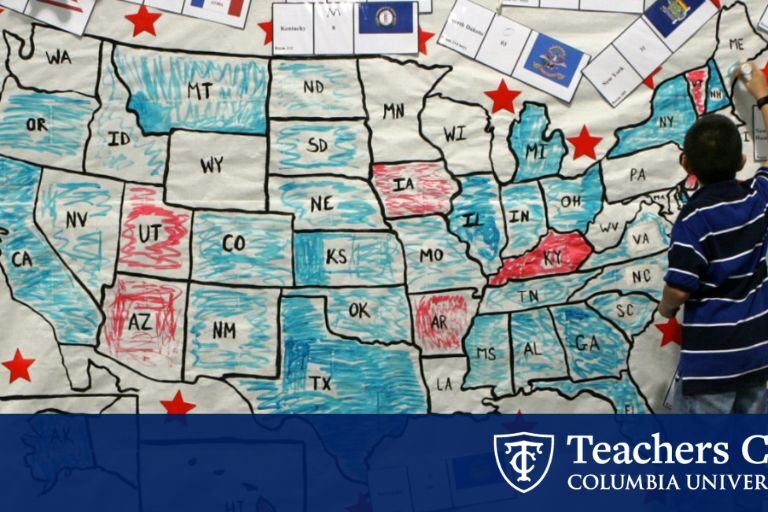As new polls, hot-takes from pundits and candidate soundbites continue to flood the homes of American voters, kids might walk away from the discourse with questions. How does the democratic process actually work? And what are the nuances that will play out on Election Day?
Teachers are in an ideal position to help young people make sense of the election season’s chaos, but the prospect can often seem daunting. In a political climate more similar to a boxing match than what it resembled decades ago, how can teachers integrate the democratic process into their classes in a productive way?
Find answers to your questions about voting and more from TC Votes.
TC experts across our faculty and alumni have identified opportunities in teaching students about the structures of democracy and its history, while offering them the chance to continue developing critical thinking skills through debate and discussion. They break down insights and applicable classroom strategies below.
Beth Rubin, Professor of Education; Michael Rebell, Professor of Law and Educational Practice; Jonathan Collins, Assistant Professor; Ioana Literat, Associate Professor of Communication, Media and Learning Technologies Design; and Sari Beth Rosenberg (M.A. ’02), educator and Co-Founder of Teachers Unify to End Gun Violence. (Photos courtesy of individuals pictured)
Vote, But Also Do More.
First and foremost, students should learn that everyone needs to exercise their right to vote in local and federal elections — with students not yet eligible to vote excited to do so in the future and ready to encourage those around them to participate. However, healthy democracies are supported by far more than just voting and civic responsibility should be more deeply ingrained in daily life, notes TC’s Beth Rubin, Professor of Education.
“Elections are important, but we need people to feel like they can be engaged members of their communities all the time, not just every four years,” says Rubin, whose work focuses on youth civic learning. “This moment provides an opening for educators to engage kids in a whole range of activities that foster active and meaningful civic participation rooted in young people’s strengths, experiences and concerns.” Rubin recommends teachers explore ways of integrating this type of civic learning into the curriculum, including civic action research, in which young people work together to analyze and take action on student-identified school and community issues.
Focus on the Government’s Structure
Helping students understand America’s government and its electoral process offers a robust starting point for educators looking to facilitate dialogue around civic engagement. “Any teacher, in a way without being partisan, can explain the system and can motivate students to engage in respectful dialogue with students with differing views,” advises TC’s Michael Rebell, Professor of Law and Educational Practice, who has dedicated his career to advancing civic education through the Center for Educational Equity (CEE).
And while some teachers may be inclined to avoid the election amid another contentious race, the experts at CEE — are “proponents of having more frequent, deeper and substantive conversations around how an election process works, how we know our election system is safe, and how we can get involved in our communities.”
American flag
Proposed Class Topics – Courtesy of Michael Rebell
Why do we have elections?
What does the Constitution say about how federal elections are run?
How has the nominee selection process differed in the past? What changes (if any) could be implemented to improve it?
What is the Electoral College? What was its role in the 2016 Election? Why are “battleground states” discussed in the news?
Why do we have the Electoral College? How did it originate?
Bonus: For high school students, Rebell recommends a debate in which students argue in favor or against getting rid of the Electoral College, and exploring what changes it would prompt.
Embrace Local Opportunities
While all eyes are on the race for America’s Oval Officeoval office, numerous local elections will also take place on Election Day — including battles for school board seats in many districts across the country. For students, this offers an opportunity to “learn about the institution that makes the decisions that directly impact them” — from what they eat to where they attend school, explains TC’s Jonathan Collins, Assistant Professor of Politics and Education, and Associate Director of CEE.
Teachers shouldn’t be teaching horse-race politics. We shouldn’t be teaching kids who is up in the polls and disseminating information from online or TV attack ads. But this is a golden opportunity to teach kids about process.
Jonathan Collins, Assistant Professor and Associate Director of CEE
Read more about the political landscape of American school boards in this interview with Collins and TC colleague Jeffrey Henig.
“We’re relying on schools to be a gateway for a future of opportunity, so there’s no better place to start thinking about civics education and student empowerment than school boards,” says Collins, whose research focuses on school-based democratic innovation. “Learning about how they work is the first step to empowering kids to understand how school boards work, how they govern and how they can be active and engaged, and holding school boards accountable for the things they need to see.”
(Photo: iStock)
Leave Room for Respectful Discourse
While educators can integrate civic education into the classroom in a non-partisan way, it is an assumed risk that political issues could come up in classroom discussion — especially among older students. For Rubin, expecting students to distill their fears, dreams and experiences in a non-partisan way is an unrealistic goal — and teachers should instead focus on the opportunity for productive discussion.
Find more resources and activities from DemocracyReady NY, part of TC’s Center for Educational Equity.
“Kids are surrounded by things that are messy, political and contentious and uncomfortable and polarizing – whether we talk about it in school or not,” says Rubin. “Kids are coming in with their experiences, their connections to particular ideas, their communities, and rather than trying to create classrooms where none of that matters, we should be thinking about how we shape a classroom environment where we honor everyone’s individual experience, listen to each other across difference, and engage in discourse across topics where we don’t necessarily agree.”
Kids are surrounded by things that are messy, political and contentious and uncomfortable and polarizing – whether we talk about it in school or not…We should be thinking about how we shape a classroom environment where we honor everyone’s individual experience, listen to each other across difference, and engage in discourse across topics where we don’t necessarily agree.
Beth Rubin, Professor of Education
Rubin recommends educators invest time to thoughtfully plan how students should engage with different topics — whether through personal writing, contributing to shared posters around the room or engaging with positions that differ from their own. For high school educators, Rubin recommends Justice in Schools from Harvard University for class discussion materials.
“There have to be shared guidelines for discussion and understanding of ways we’re going to listen to each other and raise issues and questions,” advises Rubin. “The goal is having discourse that is robust and respectful, and doesn’t leave anyone disempowered or pushed out of the conversation.”
Be Aware of Misinformation and Social Media Bias
While classroom discourse on the democratic process is essential, educators must also equip students to navigate challenges beyond the classroom, such as political misinformation and bias on social media.
“It’s important that we talk to students about bias in sources, whether it is information they get from content creators or seasoned journalists,” explains TC alum Sari Beth Rosenberg (M.A. ’02), a high school history teacher in NYC and Co-Founder of Teachers Unify to End Gun Violence. “We should remind students to review from whom they are receiving their information and read and review multiple sources before drawing any conclusions about a particular political topic. It is our obligation as educators to cover the election with students, allowing them to engage in discussions, analysis and critical thinking to better understand the candidates’ positions and what is at stake.”
(Photo: iStock)
As social media continues to shape how young people engage with the world, TC’s Ioana Literat, Associate Professor of Communication, Media and Learning Technologies Design, emphasizes its impact but encourages students to exercise caution. Focusing on youth civic engagement through platforms like TikTok, Literat shares, “We know social algorithms can be really impactful in promoting content that resonates with younger users and is engaging; political videos can quickly go viral and reach millions. Sometimes, that content is not always truthful or accurate.”
Yet Literat explains that social media can serve as a positive gateway to get students more involved in civic education. “I refer to social media as a “political sandbox “because students can really experiment with their political voice. There’s a lot of research that shows that youth is such a formative period for political socialization. It [social media] gets them interested and conveys political messages in a way that is relatable and appealing.”
— Morgan Gilbard and Jackie Teschon
Published Friday, Sep 13, 2024

